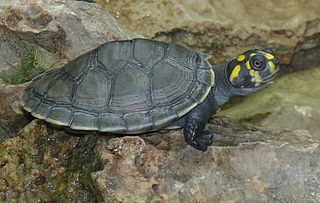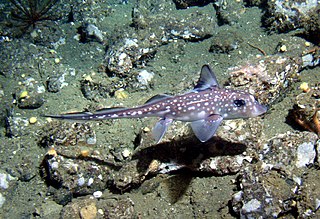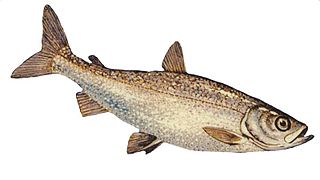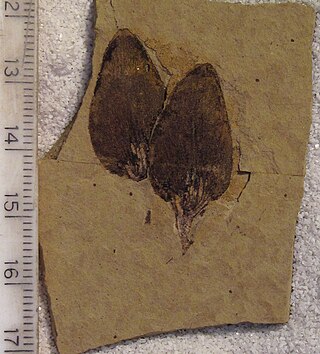
The sap beetles, also known as Nitidulidae, are a family of beetles.

Podocnemididae is a family of pleurodire (side-necked) turtles, once widely distributed. Most of its 41 genera and 57 species are now extinct. Seven of its eight surviving species are native to South America: the genus Peltocephalus, with two species, only one of which is extant ; and the genus Podocnemis, with six living species of South American side-necked river turtles and four extinct. There is also one genus native to Madagascar: Erymnochelys, the Madagascan big-headed turtle, whose single species E. madagascariensis.

Chimaeras are cartilaginous fish in the order Chimaeriformes, known informally as ghost sharks, rat fish, spookfish, or rabbit fish; the last three names are not to be confused with rattails, Opisthoproctidae, or Siganidae, respectively.

The Typhlopidae are a family of blind snakes. They are found mostly in the tropical regions of Africa, Asia, the Americas, and all mainland Australia and various islands. The rostral scale overhangs the mouth to form a shovel-like burrowing structure. They live underground in burrows, and since they have no use for vision, their eyes are mostly vestigial. They have light-detecting black eye spots, and teeth occur in the upper jaw. Typhlopids do not have dislocatable lower jaw articulations restricting them to prey smaller than their oral aperture. The tail ends with a horn-like scale. Most of these species are oviparous. Currently, 18 genera are recognized containing over 200 species.

The freshwater whitefish are fishes of the subfamily Coregoninae, which contains whitefishes and ciscoes, and is one of three subfamilies in the salmon family Salmonidae. Apart from the subfamily Coregoninae, the family Salmonidae includes the salmon, trout, and char species of the subfamily Salmoninae, and grayling species of the subfamily Thymallinae. Freshwater whitefish are distributed mainly in relatively cool waters throughout the northern parts of the Northern Hemisphere.

Gryposuchus is an extinct genus of gavialid crocodilian. Fossils have been found from Argentina, Colombia, Venezuela, Brazil and the Peruvian Amazon. The genus existed during the Miocene epoch. One recently described species, G. croizati, grew to an estimated length of 10 metres (33 ft). Gryposuchus is the type genus of the subfamily Gryposuchinae, although a 2018 study indicates that Gryposuchinae and Gryposuchus might be paraphyletic and rather an evolutionary grade towards the gharial.
Liushusaurus is an extinct genus of lizard described by Susan E. Evans and Yuan Wang in 2010. The genus has a single species, Liushusaurus acanthocaudata, and is known from eight fossils, several of which preserve soft tissue detail. The specimens were found in the Lower Cretaceous aged Yixian Formation of Northeast China. Liushusaurus is one of eight lizards that are known and have been named from the Yixian Formation, part of the diverse Jehol Biota ecosystem.
The Astoria Formation is a geologic formation in Washington state & Oregon. It preserves fossils dating back to the early to middle Miocene.
2015 in paleoentomology is a list of new fossil insect taxa that were described during the year 2016, as well as other significant discoveries and events related to paleoentomology that were scheduled to occur during the year.

Pseudolarix wehrii is an extinct species of golden larch in the pine family (Pinaceae). The species is known from early Eocene fossils of northern Washington state, United States, and southern British Columbia, Canada, along with late Eocene mummified fossils found in the Qikiqtaaluk Region, Nunavut, Canada.
This paleoentomology list records new fossil insect taxa that were to be described during the year 2021, as well as notes other significant paleoentomology discoveries and events which occurred during that year.
This paleoentomology list records new fossil insect taxa that are to be described during the year 2022, as well as notes other significant paleoentomology discoveries and events which occurred during that year.

Trachytherus is an extinct genus of mesotheriid notoungulate that lived from the Late Oligocene to the Early Miocene in what is now South America.
This list of 2023 in paleoentomology records new fossil insect taxa that are to be described during the year, as well as documents significant paleoentomology discoveries and events which occurred during that year.
The Paleobiota of the Klondike Mountain Formation comprises a diverse suite of Early Eocene plants and animals recovered from North Central Washington State. The formation outcrops in locations across the north western area of Ferry County, with major sites in Republic, north west of Curlew Lake, and on the Toroda Creek area. The formation is the southern most of the Eocene Okanagan Highlands, sharing much of the paleoflora and paleofauna with site across Central and southern British Columbia.

Debeckius is a genus of scarab beetles. It is monotypic, being represented by the single species, Debeckius beccarii. It is native to New Guinea. It was previously assigned to the genus Beckius, but that name was preoccupied by a fossil whitefish.








